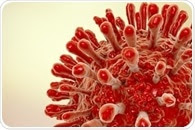| | Protozoans protect pathogenic bacteria and enhance their infectious potential  Single celled organisms in the environment are protecting pathogenic bacteria and priming them for human infection, an international team of researchers has discovered. Microorganisms such as protozoa and bacteria have been conducting an "arms race" for billions of years. Single celled organisms in the environment are protecting pathogenic bacteria and priming them for human infection, an international team of researchers has discovered. Microorganisms such as protozoa and bacteria have been conducting an "arms race" for billions of years. | |
|
| | New way to prevent malaria bugs from breeding  A new international collaboration reports that the compound called TCMDC-135051 is capable of preventing the synthesis of a protein that is required for growth in Plasmodium falciparum, one of the species of the Plasmodium parasite that causes malaria. The study, reported in the journal Science, could lead to the development of a new antimalarial drug. A new international collaboration reports that the compound called TCMDC-135051 is capable of preventing the synthesis of a protein that is required for growth in Plasmodium falciparum, one of the species of the Plasmodium parasite that causes malaria. The study, reported in the journal Science, could lead to the development of a new antimalarial drug. | |
|
| | New study shows response to HIV vaccine in 6 weeks  A new study using DNA-based and protein HIV vaccines in various combinations shows that antibody and cellular immune response occurs within 6 weeks from the date of vaccination, and the combination must be administered together for the most rapid protection. This will enable more large-scale testing of the vaccine for effectiveness. A new study using DNA-based and protein HIV vaccines in various combinations shows that antibody and cellular immune response occurs within 6 weeks from the date of vaccination, and the combination must be administered together for the most rapid protection. This will enable more large-scale testing of the vaccine for effectiveness. | |
|
| | Computer model predicts location of future Ebola virus outbreaks  The Ebola virus disease (EVD) is a deadly infection that is highly contagious. It has taken thousands of lives across history, with a number of outbreaks mostly happening in West Africa. In the worse outbreak, between 2014 and 2016, there had been 28,616 cases of EVD, 11,310 of whom had died in the continent. Overseas, there had been 36 cases and 15 deaths. The Ebola virus disease (EVD) is a deadly infection that is highly contagious. It has taken thousands of lives across history, with a number of outbreaks mostly happening in West Africa. In the worse outbreak, between 2014 and 2016, there had been 28,616 cases of EVD, 11,310 of whom had died in the continent. Overseas, there had been 36 cases and 15 deaths. | |
|
| | Scientists discover how malaria switched host from African gorillas to humans  Researchers have revealed the series of events that probably led to the world’s deadliest form of malaria being able to jump from ancient great apes to humans. Scientists at the Wellcome Sanger Institute and the University of Montpellier found that a chance genetic mutation that arose in Plasmodium falciparum around 50,000 years ago enabled the parasite to switch host from gorillas to humans. Researchers have revealed the series of events that probably led to the world’s deadliest form of malaria being able to jump from ancient great apes to humans. Scientists at the Wellcome Sanger Institute and the University of Montpellier found that a chance genetic mutation that arose in Plasmodium falciparum around 50,000 years ago enabled the parasite to switch host from gorillas to humans. | |
|
| | Study sheds new light on transmission dynamics of HIV-1B virus in Indonesia  Research into the molecular phylogeny (evolutionary history) of the HIV-1B virus in Indonesia has succeeded in illuminating the transmission period and routes for three clades (main branches of the virus). This includes a clade thought to be unique to Indonesia, as well as clades that spread from Thailand, Europe and America in the 1970s and 1980s. Research into the molecular phylogeny (evolutionary history) of the HIV-1B virus in Indonesia has succeeded in illuminating the transmission period and routes for three clades (main branches of the virus). This includes a clade thought to be unique to Indonesia, as well as clades that spread from Thailand, Europe and America in the 1970s and 1980s. | |
|
| | Texas Biomed scientists continue testing therapies and vaccines for Ebola virus  In mid-August 2019, human clinical trials were halted in the current Ebola epidemic that has claimed more than 2,100 lives in Africa. The findings resulted in the discontinuation of two of the drugs in the trial. Future patients will be randomly assigned to receive either REGN-EB3 (Regeneron) or mAb114 (Ridgeback Biotherapeutics) in an extension phase of the study. In mid-August 2019, human clinical trials were halted in the current Ebola epidemic that has claimed more than 2,100 lives in Africa. The findings resulted in the discontinuation of two of the drugs in the trial. Future patients will be randomly assigned to receive either REGN-EB3 (Regeneron) or mAb114 (Ridgeback Biotherapeutics) in an extension phase of the study. | |
|
| | Common bug repellent may chemically 'cloak' humans from malaria-carrying mosquitos  Since its invention during the Second World War for soldiers stationed in countries where malaria transmission rates were high, researchers have worked to pinpoint precisely how DEET actually affects mosquitos. Past studies have analyzed the chemical structure of the repellent, studied the response in easier insects to work with, such as fruit flies, and experimented with genetically engineered mosquito scent receptors grown inside frog eggs. Since its invention during the Second World War for soldiers stationed in countries where malaria transmission rates were high, researchers have worked to pinpoint precisely how DEET actually affects mosquitos. Past studies have analyzed the chemical structure of the repellent, studied the response in easier insects to work with, such as fruit flies, and experimented with genetically engineered mosquito scent receptors grown inside frog eggs. | |












No comments:
Post a Comment